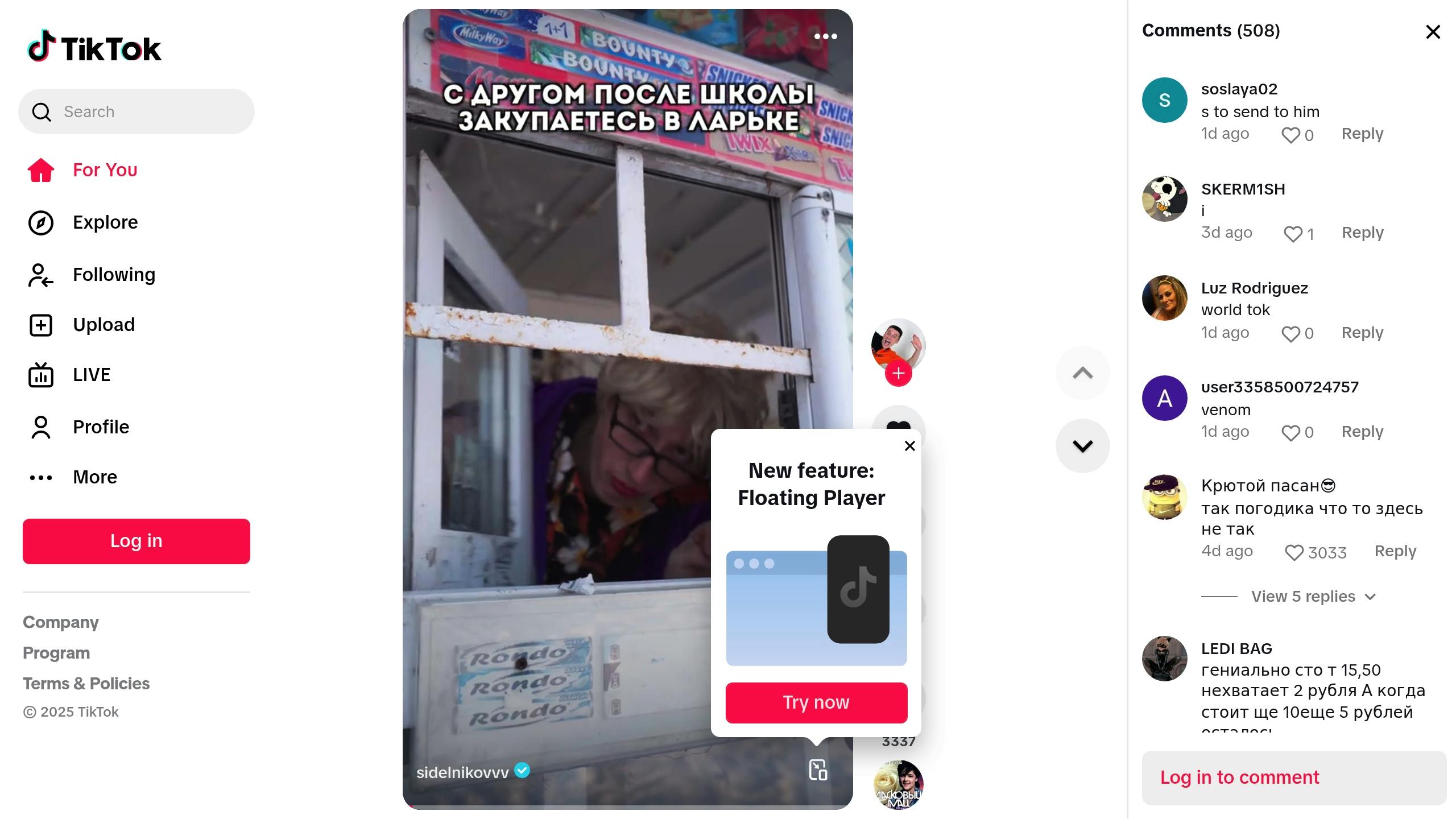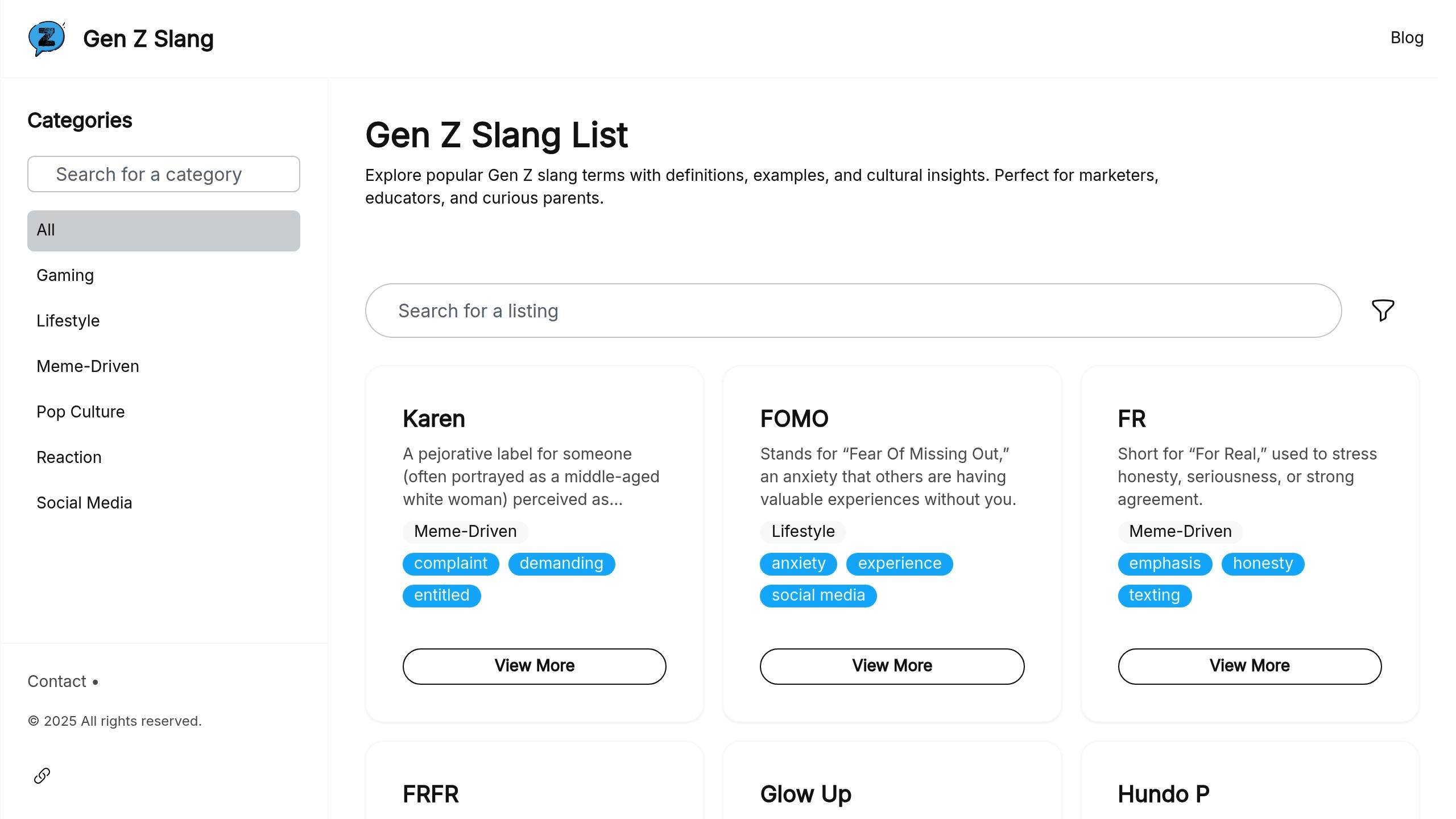TikTok is changing how Gen Z communicates, especially through reaction phrases. With 650,000 daily sign-ups and users spending 58 minutes daily on the app - more than YouTube or Instagram - TikTok drives language trends faster than ever. Its algorithm pushes new slang through trending videos, comment sections, and remixable content. Popular examples like "sheesh" show how quickly phrases spread and evolve.
Key insights:
- 41% of TikTok users are Gen Z, making it a hub for their slang.
- TikTok’s "For You Page" algorithm helps slang go viral.
- The Gen Z Slang Directory organizes phrases with definitions, examples, and origins, including ties to AAVE.
- TikTok captures trends in real time, while the Directory provides structured explanations.
| Aspect | TikTok | Gen Z Slang Directory |
|---|---|---|
| Update Speed | Real-time | Scheduled updates |
| Content Creation | User-driven (55% create content) | Structured and documented |
| Cultural Context | Community-driven meanings | Explains origins and evolution |
| Accessibility | App-specific | Open to all as a reference |
TikTok shapes slang as it happens, while the Directory helps decode and preserve it. Together, they reflect how Gen Z expresses itself today.
TikTok Teacher Breaks Down Gen Z Slang Terms

1. TikTok's Impact on Slang Creation
TikTok’s "For You Page" (FYP) focuses on relevance rather than creator popularity, making it a powerful engine for spreading new reaction phrases quickly [2]. By analyzing watch time, likes, shares, and comments, TikTok’s algorithm fine-tunes its recommendations, leading to the organic spread of these phrases [2][3].
"The more you engage with videos on the app, the more personalized your recommendations become. From the moment you start your TikTok journey, your first set of likes, comments, and replays will initiate recommendations as the system begins to learn more about your video tastes."
TikTok emphasizes that early user interactions - such as liking, commenting, and replaying videos - play a major role in shaping personalized content recommendations [3]. This precision in targeting drives rapid sharing and sparks creativity, especially in comment sections [4].
Comment sections have become a hotspot for creating new reaction phrases, often surpassing the creativity of the videos themselves [5]. The ability to reply to comments with video responses further amplifies these phrases, encouraging more engagement and community participation [4].
Take the "sheesh" trend as an example. TikTok user @meetjulio posted a video featuring a frog surrounded by a chorus of "sheeshes." This simple clip inspired over 100,000 spin-off videos, turning the sound into a widely used reaction phrase [6].
"Sometimes people use it when someone does something clumsy or stupid. If someone trips and falls, then their friends might say it to make fun of the situation." [6]
The success of reaction phrases on TikTok often depends on three main factors:
- Sound integration: Using trending audio clips from TikTok’s library.
- Strategic hashtags: Leveraging relevant tags to boost visibility.
- Contextual evolution: Adapting phrases to fit different scenarios.
Brands have also tapped into TikTok’s recommendation engine to great effect. For instance, e.l.f. Cosmetics achieved a 56% drop in CPA and a 63% year-over-year growth in impressions by targeting their audience strategically [2].
Professor Julian McAuley notes that while TikTok’s techniques might seem straightforward, its massive user base and engaged community create an environment where trends can thrive [2].
sbb-itb-ca058e4
2. Gen Z Slang Directory Overview

The Gen Z Slang Directory (https://genzslanglist.com) is a go-to guide for decoding TikTok-inspired reaction phrases. With TikTok shaping how Gen Z communicates, this directory serves as a helpful tool for keeping up with their constantly changing language.
It breaks down trending reaction phrases into three main parts:
| Component | Purpose | Example |
|---|---|---|
| Definition | Explains the term | Provides meaning and context |
| Usage Examples | Shows how it's applied | Demonstrates scenarios |
| Cultural Context | Offers background details | Explains origin and evolution |
By documenting these phrases, the directory highlights TikTok's role in shaping modern language. Popular terms like "IYKYK" (If You Know You Know) and "POV" (Point of View) are prime examples of how these expressions engage audiences and gain popularity [1].
The directory also notes that many Gen Z slang terms have roots in African American Vernacular English (AAVE) [7][9], providing insight into the cultural significance behind these phrases.
Updated regularly, the directory reflects shifts in language influenced by region, culture, and generational trends [8]. For educators and parents, it offers practical advice on understanding Gen Z communication - focusing on context rather than memorizing terms [7].
This resource underscores TikTok's ongoing influence on how Gen Z connects and communicates.
Benefits and Limitations
Comparing TikTok's fast-moving slang evolution with the Gen Z Slang Directory's structured reference style highlights how each platform contributes to decoding Gen Z reaction phrases. TikTok thrives on a constantly changing, community-driven environment, while the Directory offers a more organized, educational approach. Together, they provide a fuller picture of how Gen Z communicates.
| Aspect | TikTok | Gen Z Slang Directory |
|---|---|---|
| Update Speed | Real-time changes | Scheduled updates |
| Content Creation | 55% of users create content [11] | Carefully documented |
| Cultural Context | Community-driven and organic | Structured and educational |
| Accessibility | Platform-specific | Open to all as a reference |
| Learning Curve | Requires active engagement | Easy to follow and systematic |
In 2021 alone, 15 slang terms gained broad popularity [1]. TikTok acts as a creative hub where these terms emerge and spread, while the Directory captures and explains them for broader understanding. TikTok’s dynamic nature fosters a sense of exclusivity, as its "coded language" connects active users while leaving others behind.
The Gen Z Slang Directory, on the other hand, takes a more deliberate approach. It archives slang with clear definitions and cultural context, often acknowledging its roots in AAVE [7]. This structured format helps users grasp not just the meanings of phrases but their deeper cultural significance.
However, TikTok's rapid pace brings challenges. As Rex Woodbury points out:
"Gen Z language evolves rapidly, fueled by the furious speed of internet culture" [11]
This speed makes it tough for reference tools like the Directory to keep up. With 57% of Gen Z using TikTok for news updates [10], the platform often sets trends faster than they can be documented. While the Directory ensures accuracy and cultural respect, it inevitably lags behind TikTok's immediate shifts.
Both platforms play distinct but complementary roles: TikTok as the experimental space where Gen Z slang is born and evolves, and the Gen Z Slang Directory as the thoughtful archive that explains and preserves these linguistic trends.
Key Takeaways
TikTok is reshaping how Gen Z develops and spreads slang. The platform has sped up the way new expressions emerge, moving beyond the slower, more traditional methods of linguistic change.
Emily Brewster, Senior Editor and Editorial Ambassador at Merriam-Webster, highlights this shift:
"Your sense that slang is shifting more quickly now is true in that language is becoming popularized more quickly" [12]
TikTok’s influence on slang can be broken down into three main areas:
| Dimension | TikTok's Role | Directory’s Role |
|---|---|---|
| Speed | Real-time slang evolution | Provides structured documentation |
| Access | Direct exposure to how slang is used now | Offers clear definitions for everyone |
| Cultural Context | Community-driven meanings | Explains origins, including AAVE [7] |
Together, TikTok and the Gen Z Slang Directory offer a blend of immediacy and structure. TikTok captures slang as it happens, while the Directory organizes and explains it, making it easier to understand and use.
For marketers and educators, the Directory is a reliable tool for decoding established slang and its cultural background. TikTok, on the other hand, gives a front-row seat to how language evolves in real time.
Jessi Grieser, Assistant Professor of English Linguistics at the University of Tennessee, Knoxville, explains how slang reflects social identity:
"What you're doing with slang is that you're showing that you're a participant in a particular type of culture or age group. And as the slang starts to circulate and different social groups use it, it takes on different social meanings. Depending on how admirable those social groups are, that can end up leading to a loss of the slang." [12]
This back-and-forth between TikTok's fast-paced trends and the Directory's detailed records paints a full picture of how Gen Z communicates today.

